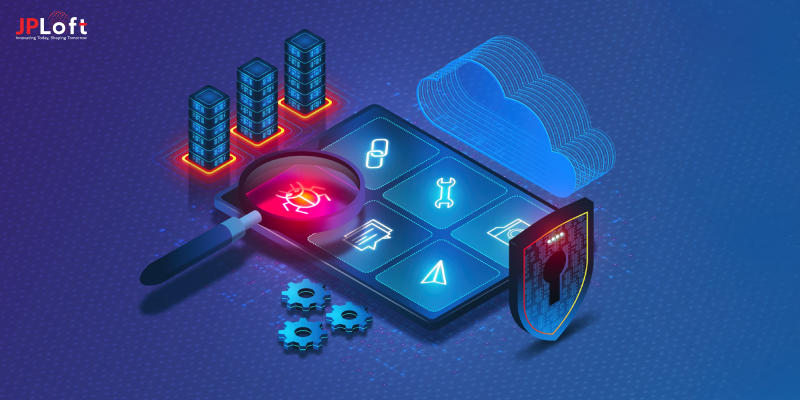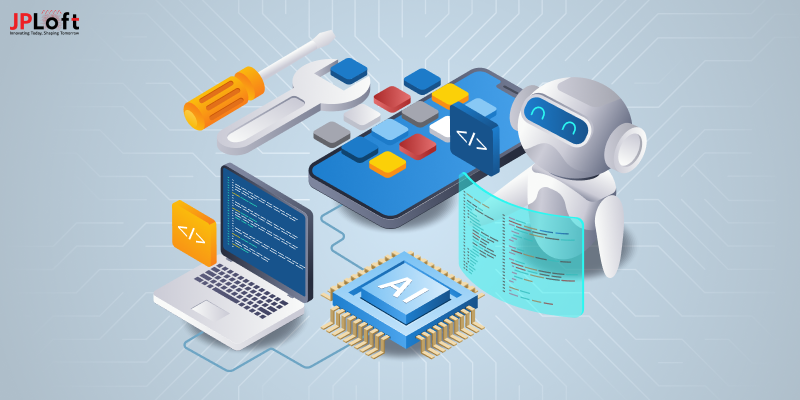Key Takeaways
Mobile app maintenance is the continuous process of updating, improving, and optimizing your app after launch to ensure it performs smoothly, stays secure, and adapts to new devices and OS updates.
Common app maintenance mistakes include skipping updates, ignoring security checks, neglecting user feedback, and misjudging maintenance budgets that lead to performance and retention issues.
Schedule regular updates, automate testing, back up data, monitor analytics, and integrate AI-driven tools to detect and fix issues before they escalate.
Benefits of continuous app maintenance include consistent upkeep improves stability, user trust, and ROI that can turn your app into a long-term, scalable digital asset instead of a short-lived product.
As a trusted app maintenance company, JPLoft offers proactive monitoring, real-time performance optimization, and AI-powered solutions to keep your app fast, secure, and future-ready.
Imagine launching your dream mobile app after months of hard work, it’s sleek, user-friendly, and gaining traction fast.
But a few weeks later, users start complaining about crashes, slow loading, and security bugs. That’s where most businesses go wrong, not in development, but in what comes after it.
App maintenance isn’t just about fixing bugs; it’s about keeping your app alive, relevant, and high-performing in a constantly evolving digital space.
Yet, many developers and brands unknowingly make small app maintenance mistakes that lead to big problems, poor performance, lost users, and rising costs.
In this blog, we’ll uncover the list of mobile app maintenance mistakes and show you exactly how to fix them before they impact your success.
What Is Mobile App Maintenance?
Launching an app is only the beginning, the real work starts once it’s live. Mobile app maintenance is the ongoing process of updating, improving, and optimizing your app to ensure it continues to deliver a seamless user experience.
It involves regular bug fixes, feature upgrades, performance tuning, and security checks to keep your app compatible with the latest devices and operating systems.
Ignoring routine updates or skipping performance checks can lead to costly app maintenance errors that affect stability and user trust.
In short, proper mobile app maintenance keeps your product reliable, secure, and future-ready in an ever-changing tech world.
Why Mobile App Maintenance Matters in 2025?
The digital world of 2025 is faster, smarter, and more competitive than ever. Users expect lightning-fast apps, zero downtime, and personalized experiences. That’s why app maintenance isn’t just an afterthought; it’s a necessity.
Here’s why it matters more than ever this year:
1. Ensure Peak Mobile App Performance
Consistent maintenance keeps your app fast, stable, and compatible with the latest OS versions, devices, and technologies. It helps you prevent mobile app performance issues before they affect the user experience.
2. Strengthen Security & Build Trust
Routine updates and Security Audits in App Maintenance protect user data, fix vulnerabilities, and keep your app compliant with the latest cybersecurity standards, building lasting trust with users.
3. Improve User Experience & Retention
Every update makes your app smoother and more engaging. Fixing bugs, improving UI, and adding fresh features through regular maintenance boosts satisfaction and keeps users coming back.
4. Gain Competitive Advantage
Brands that consistently maintain and upgrade their apps stay ahead of competitors. A well-maintained app ranks better, performs better, and adapts faster to new market trends.
5. Leverage the Role of AI in App Maintenance
AI-powered monitoring tools can now predict bugs, automate routine tasks, and optimize app performance in real time. Embracing the role of AI in app maintenance not only reduces downtime but also ensures your app runs smarter and more efficiently.
6. Save Long-Term Costs
Fixing small issues early prevents expensive overhauls later. Regular maintenance reduces technical debt, extends app lifespan, and maximizes your ROI.
In short, maintaining the app consistently in 2025 isn’t just about fixing what’s broken, it’s about enhancing performance, security, and user delight to keep your app future-ready.
Common App Maintenance Mistakes to Avoid
Imagine this: you’ve launched a beautiful, feature-rich mobile app that users initially love. Downloads are booming, feedback is positive, and your growth charts are shooting upward. But a few months later, performance starts to dip.
Users complain about bugs, crashes, and outdated designs. Ratings drop. What went wrong? The truth is, many businesses unknowingly fall victim to app maintenance mistakes that quietly erode user trust and performance over time.
Regular maintenance isn’t just about quick fixes; it’s about keeping your app healthy, adaptable, and future-ready.
Below is a comprehensive list of mobile app maintenance mistakes and, more importantly, how to fix them before they impact your app’s success.
1] Ignoring Regular Updates and Bug Fixes
One of the most common app maintenance mistakes to avoid is delaying updates or skipping them altogether. Many developers adopt the “if it’s working, don’t touch it” approach, which often backfires. Operating systems evolve, APIs change, and user expectations shift constantly.
When updates are neglected, apps become incompatible, buggy, or even vulnerable to attacks. Users start experiencing mobile app performance issues, sluggish loading times, app crashes, and poor responsiveness.
Solution:
Think of app maintenance like regular health check-ups. Even if your app “feels” fine, schedule periodic updates to address bugs, improve UI/UX, and ensure OS compatibility. Tools that track release schedules or automate version control make this process smooth.
Whether you’re looking to maintain your iOS app or an Android one, consistency builds user confidence and longevity.
2] Overlooking Security Checks and Vulnerability Scans
Data security isn’t optional; it’s essential. Yet, many developers still treat it as an afterthought, leading to major app maintenance errors that can cost a brand its credibility. Without continuous monitoring, outdated libraries or weak encryption can open doors for hackers.
Nowadays, even a minor security lapse can snowball into data leaks, user mistrust, and compliance penalties. Regularly assessing your app’s defense layer is not just a best practice, it’s a necessity for long-term sustainability.
Solution:
Integrate security audits in app maintenance into your workflow. Conduct vulnerability scans and penetration tests regularly. Use secure coding standards and encryption protocols to protect sensitive information.
Keeping your app compliant with GDPR or CCPA regulations isn’t just a legal necessity, it’s a trust factor that users value deeply.
3] Ignoring User Feedback and Real-Time Analytics
Ignoring users is one of the mistakes that affects app maintenance the most. Imagine your audience consistently reporting crashes or login issues, and you never respond. Frustration builds, negative reviews pile up, and uninstall rates soar.
Over time, this communication gap makes users feel undervalued, pushing them toward competitors who listen and improve. The result? Lost trust, declining retention, and an app that gradually fades out of relevance.
Solution:
Actively monitor user feedback and analytics dashboards. Tools like Firebase, App Annie, or Mixpanel can help identify patterns of dissatisfaction.
By listening to users, you gain real-world insights into mobile app performance issues, allowing you to fix them before they escalate. Remember, feedback is not criticism; it’s a free roadmap for improvement.
4] Failing to Optimize App Performance
Even the most feature-rich app can fail if it’s slow or unstable. Poor performance optimization is among the most dangerous mistakes to avoid while maintaining an app, leading to user churn and low retention.
A single lag or crash can frustrate users enough to abandon your app altogether. Remember, speed, responsiveness, and stability define user experience. Regular audits, testing, and optimization ensure your app feels light, fast, and dependable across all sessions.
Solution:
Regularly test and optimize your app’s speed, battery usage, and data consumption. Utilize caching techniques, optimize image sizes, and ensure smooth API responses.
Incorporating advanced app maintenance tools & techniques can help automate performance tests and identify weak spots in real time. A smooth, fast experience keeps users coming back for more.
5] Neglecting Compatibility Across Devices and Platforms
Your app might look flawless on one device but broken on another. Failing to test compatibility across screen sizes, resolutions, and operating systems is a very common mistake in app maintenance that damages usability.
With new devices launching every few months, compatibility testing isn’t optional, it’s essential. By ensuring your app adapts perfectly to every screen, you not only retain users but also project a sense of quality and professionalism that boosts brand trust.
Solution:
App testing on multiple devices using cloud-based testing platforms. Simulate different OS environments to detect layout issues or functionality gaps.
Compatibility is especially crucial when trying to maintain the app, where Apple’s ecosystem evolves quickly. Regular testing ensures your app runs flawlessly everywhere your users are.
6] Not Leveraging Automation in Maintenance
Relying entirely on manual updates or testing is both inefficient and risky. It’s one of the top app maintenance mistakes that slows down teams and increases the margin for human error.
Automation helps streamline processes like regression testing, bug tracking, and deployment. In fact, it’s a game-changer for teams aiming to save time while improving accuracy.
Solution:
Embrace automation wherever possible. Continuous Integration and Continuous Deployment (CI/CD) pipelines can handle testing, bug detection, and performance monitoring efficiently.
In fact, how automation is transforming mobile app maintenance is one of 2025’s biggest trends, helping developers detect issues in real-time, deploy faster, and ensure greater accuracy with minimal effort.
7] Skipping Data Backup and Recovery Planning
Losing user data after a crash or system failure can be catastrophic. Sadly, many teams overlook backup planning, making it one of the most overlooked mistakes that affect app maintenance.
Regular automated backups and a solid disaster recovery plan act as your safety net, ensuring business continuity and user trust even during unforeseen events. Many leading companies now emphasize automated backup strategies as a core part of their maintenance workflow to prevent such disasters.
Solution:
Always implement automated data backups, preferably daily or weekly. Use cloud-based solutions like AWS Backup or Google Cloud Storage.
Have a disaster recovery plan in place so you can restore lost data within hours, not days. It’s a small step that protects both your business and your reputation.
8] Misjudging the App Maintenance Budget
Many startups assume that maintenance costs end after launch. However, underestimating or mismanaging your mobile app maintenance costs is one of the biggest app maintenance mistakes in the long term. Without a budget, you can’t support consistent updates or performance enhancements.
Treat app maintenance as an ongoing investment, not an expense. A well-planned budget covers upgrades, bug fixes, and innovations, ensuring your app evolves seamlessly with market demands and technological changes.
Solution:
Plan for at least 15–25% of your annual app development budget to go toward maintenance. This includes updates, testing, bug fixes, and monitoring tools. Proper budgeting ensures your app evolves with technology and stays competitive.
A clear financial roadmap also helps you prioritize critical updates and avoid unexpected expenses that can derail long-term growth.
9] Ignoring AI and New Tech
In 2025, ignoring innovation is equivalent to falling behind. Many developers make mistakes that affect app maintenance by failing to adapt to new technologies like building an AI app, machine learning, and predictive analytics.
AI can now predict bugs, identify performance issues, and even automate testing with high accuracy. Nowadays, AI in businesses is transforming how companies manage, monitor, and optimize their apps in real time. It’s no longer futuristic, it’s the new standard for smart, data-driven optimization that keeps your app one step ahead.
Solution:
Embrace emerging tech to stay ahead. The AI in app maintenance goes beyond automation, it enables predictive maintenance, anomaly detection, and intelligent bug resolution.
Partnering with expert AI app development services can help you implement smart analytics, automated testing, and real-time monitoring. These AI-powered tools can analyze user behavior and performance data to suggest improvements before issues occur, ensuring a seamless and future-ready app experience.
10] Treating App Maintenance as a One-Time Task
Perhaps the most damaging of all mobile app maintenance mistakes is assuming maintenance ends after a few updates. An app is like a living organism, it needs continuous care, monitoring, and upgrades to thrive.
Neglecting this leads to outdated features, security risks, and declining engagement. That’s why most leading mobile app development companies in the USA treat maintenance as an ongoing process rather than a post-launch chore.
Solution:
Adopt a proactive mindset. Set up regular maintenance schedules, quarterly audits, and continuous feedback loops. Think of your app as a growing product that evolves with users, not as a one-time project.
When you view maintenance as a long-term strategy, you’ll naturally avoid app maintenance mistakes that cause stagnation or failure.
App maintenance isn’t a background task, it’s the heartbeat of your app’s success. From performance optimization to security audits and automation, every step counts.
By learning from these mistakes, you not only extend your app’s life but also boost user satisfaction, ROI, and digital credibility.
Your app doesn’t just need updates, it deserves consistent care, foresight, and attention to detail.
Overcome App Maintenance Mistakes with JPLoft
Avoiding maintenance mistakes takes more than awareness; it requires expertise, consistency, and the right strategy. That’s where JPLoft steps in. As a leading provider of mobile app maintenance services, we ensure your app remains secure, fast, and future-ready.
From real-time monitoring to performance optimization and version upgrades, our team keeps your app running flawlessly across all devices. We combine proactive maintenance with the latest tools, automation, and AI insights to eliminate downtime and enhance user satisfaction.
Whether it’s fixing hidden bugs or improving scalability, JPLoft’s dedicated approach ensures your app evolves with technology, not against it. Partner with us to transform your app maintenance process into a strategic advantage that drives long-term growth and reliability.
Final Wrap-Up
App success doesn’t end at launch, it thrives on continuous improvement. By learning from these app maintenance mistakes, you can safeguard your product from performance issues, security gaps, and poor user retention.
A well-maintained app builds trust, longevity, and loyalty in a competitive digital landscape. Whether it’s automating updates, monitoring performance, or investing in proactive maintenance, every step strengthens your app’s foundation.
So, if you’re ready to take the next step, focus on regular maintenance, avoid common pitfalls, and empower your app to deliver lasting value. Remember, maintenance isn’t a cost; it’s an investment in your app’s future.
FAQs
Skipping updates, neglecting security audits, and ignoring user feedback are among the most frequent mistakes that can harm app performance and user trust.
Routine maintenance ensures bug fixes, OS compatibility, and performance optimization, preventing crashes, slow loading, and security vulnerabilities.
It ensures smooth performance, strong security, and user satisfaction by fixing bugs, adding new features, and keeping your app updated with the latest technologies.
AI can predict potential crashes, detect bugs automatically, and provide data-driven insights to optimize app stability and user experience.
Ideally, apps should be updated every 4–6 weeks, with regular monitoring in between to fix issues and implement user-driven improvements.













Share this blog